A rod of length 1.05 m having negligible mass is supported at its ends by two wires of steel (wire A) and aluminium (wire B) of equal lengths as shown in figure. The cross-sectional areas of wires A and B are 1.0 mm2 and 2.0 mm2, respectively. At what point along the rod should a mass m be suspended in order to produce (a) equal stresses and (b) equal strains in both steel and aluminium wires.
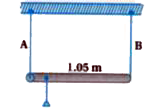 Solution in Gujrati
Solution in Gujrati
Let system 1 for streel and 2 for aluminium,
Length of steel wire A,l1=l
Area of cross section of steel wire A1=1mm2
Young.s modulus of steel wire Y1=2×1011Nm−2
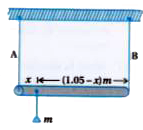
Length of aluminium l2=l
Area of cross-section
A2=2mm2
Young.s modulus Y2=7×1010Nm−2
(a) Let mass m be suspended from the rod at distance x from the end.
Let F1andF2 be the tension in two wires and there is equal stress in two wires then,
∴F1A1=F2A2
∴F1F2=A1A2
∴F1F2=12 ...(1)
Taking moment of forces about the point of suspension of mass from the rod.
F1x=F2(1.05−x)
∴F1F2=1.05−xx
∴12=1.05−xx [∵ From equation (1)]
∴x=2.1−2x
∴3x=2.1
∴x=0.7morx=70cm
(b) Let mass m be suspended from the rod at distance x from the end. There is equal strain in two wires,
Y=F/Aεl where εl= longitudinal strain
∴εl=FAY
∴ For steel wire :(εl)1=F1A1Y1
For aluminium wire :(εl)1=F1A1Y1
For aluminium wire :(εl)2=F2A2Y2
but (εl)1=(εl)2
∴F.1A1Y1=F.2A2Y2
∴F.1F.2=A1Y1A2Y2
=12×2×10117×1010
F.1F.2=107 ...(2)
Taking moment of force about the point of suspension of mass from the rod,
F.1x=F.2(1.05−x)
∴F.1F.2=1.05−xx
107=1.05−xx [∵From equation (2)]
∴10x=7.35−7x
∴17x−7.35
∴x=7.3517=0.43235mor≈43.2cm
Topper's Solved these Questions
- BOOK - KUMAR PRAKASHANCHAPTER - MACHANICAL PROPERTIES OF SOLIDS EXERCISE - SECTION-C66videos
MACHANICAL PROPERTIES OF SOLIDS
- BOOK - KUMAR PRAKASHANCHAPTER - MACHANICAL PROPERTIES OF SOLIDS EXERCISE - SECTION-D29videos
MACHANICAL PROPERTIES OF SOLIDS
- BOOK - KUMAR PRAKASHANCHAPTER - MACHANICAL PROPERTIES OF SOLIDS EXERCISE - SECTION-A TRY YOURSELF (VSQs)40videos
MACHANICAL PROPERTIES OF SOLIDS
- BOOK - KUMAR PRAKASHANCHAPTER - LAW OF MOTIONEXERCISE - (QUESTION PAPER) SECTION-D1videos
LAW OF MOTION
- BOOK - KUMAR PRAKASHANCHAPTER - MECHANICAL PROPERTIES OF FLUIDS EXERCISE - QUESTION PAPER (SECTION -C)3videos
MECHANICAL PROPERTIES OF FLUIDS
Similar Questions
What is elasticity ? What is plastic body and plasticity?
06:38View SolutionModulus of rigidity of an ideal liquid is ......
06:38View SolutionWhat are solid bodies composed ?
03:52View SolutionA 70 kg man stands in contact against the inner wall of a hollow cylindrical drum of radius 3 m rotating about its vertical axis with 200 rev/min. The coefficient of friction between the wall and his clothing is 0.15. What is the minimum rotational speed of the cylinder to enable the man to remain stuck to the wall (without falling) when the floor is suddenly removed ?
07:09View SolutionGlycerine flows steadily through a horizontal tube of length 1.5m and radius 1.0 cm . If the amount of glycerine collected per second at one is 4.0×10−3kgs−1 , what is the pressure difference between the two ends of the tube ? (Density of glycerine =1.3×10103kgm−3 and viscosity of glycerine =0.83 Pa s). [ you may also like to check if the assumption of laminar flow in the tube is correct]
12:45View SolutionA rod of length 1.05 m having negliaible mass is supported at its ends by two wires of steel (wire A) and aluminium (wire B) of equal lengths as shown in fig. The cross-sectional area of wire A and B are 1mm2 and 2mm2, respectively . At what point along the rod should a mass m be suspended in order to produce (a) equal stresses and (b) equal strains in both steel and aluminium wires. Given,
Ysteel=2×1011Nm−2andY−(aluminium)=7.0×1010N−2
 06:07View Solution
06:07View SolutionA rod of length 1.05 m having negliaible mass is supported at its ends by two wires of steel (wire A) and aluminium (wire B) of equal lengths as shown in fig. The cross-sectional area of wire A and B are 1mm2 and 2mm2, respectively . At what point along the rod should a mass m be suspended in order to produce (a) equal stresses and (b) equal strains in both steel and aluminium wires. Given,
Ysteel=2×1011Nm−2andY−(aluminium)=7.0×1010N−2
 05:42View Solution
05:42View SolutionA rod PQ of length 1.05m having negligible mass is supported at its ends by two wires one of stell (wire A), and the other of aluminium (wire B) of equal lengths as shown in fig. The cross-sectional areas of wires A and B are 1.0mm2 and 2.0mm2 respectively. At what point along the rod a load W be suspended in order to produce
(a) equal stress, (b) equal strains in both steel an aluminium.
(Ysteel=200GPa,Yaluminium=70GPa)
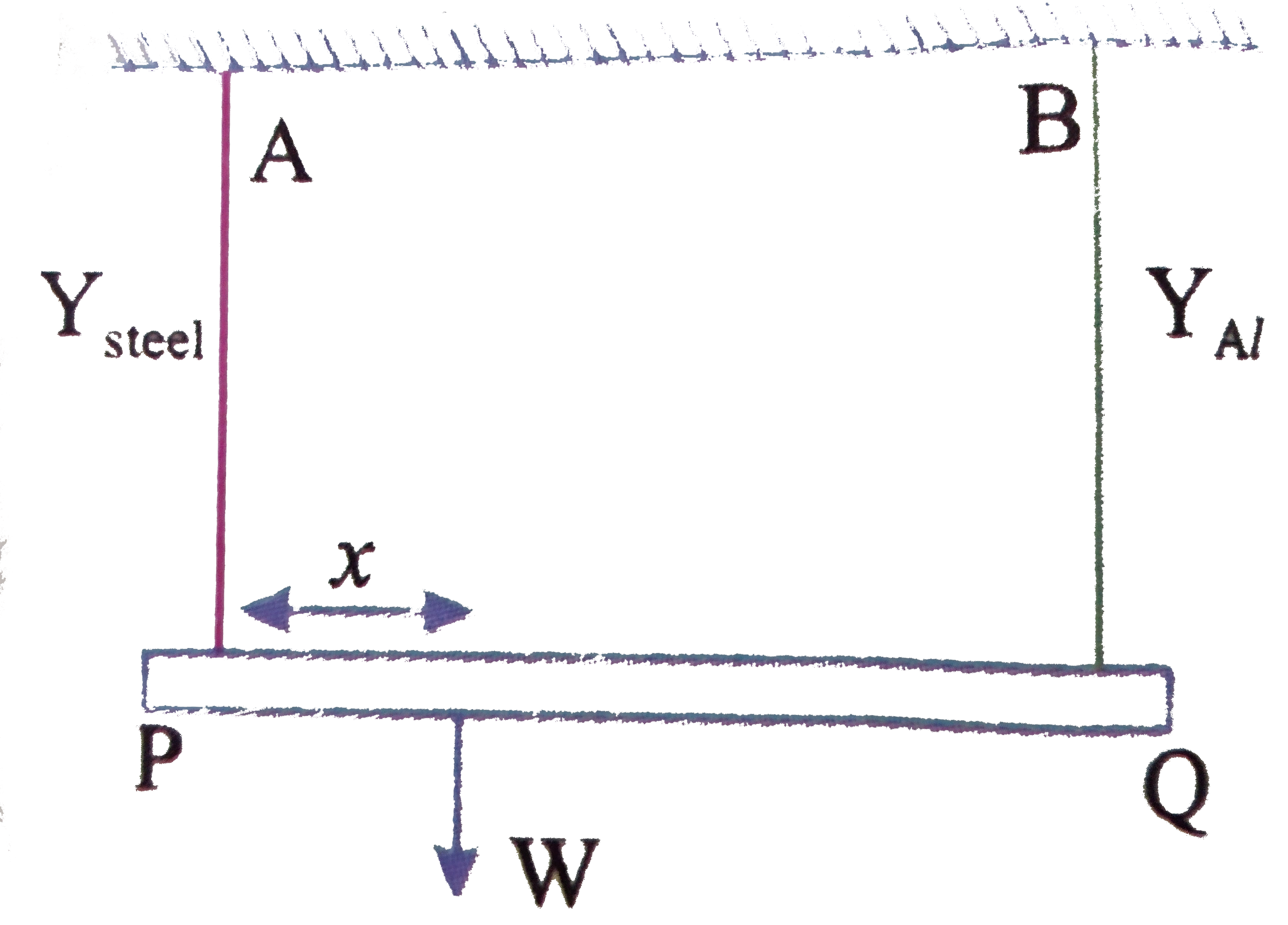 06:26View Solution
06:26View Solution1.05 m लम्बाई तथा नगण्य द्रव्यमान कि एक छड़ को बराबर लम्बाई के दो तारो , एक इस्पात का (तार A) तथा दूसरे ऐलुमिनियम का तार (तार B) द्वारा सिरों से लटका दिया गया है, जैसे कि चित्र में दिखाया गया है। A तथा B के तारो से अनुप्रस्थ प्रतिच्छेद के क्षेत्रफल क्रमश: 1.0mm2 और 2.0mm2 है। छड़ से कितनी दूर बिंदु से एक द्रव्यमान m को लटका दिया जाए ताकि इस्पात तथा ऐलुमिनियम के तारो में (A) समान प्रतिबल तथा (B) समान विकृति उत्पन्न हो।
 07:43View Solution
07:43View Solution1⋅05 m लंबाई तथा नगण्य द्रव्यमान की एक छड़ को बराबर लंबाई के दो तारों, एक इस्पात का ( तार A ) तथा दूसरा ऐल्युमिनियम का तार ( तार B ) द्वारा सिरों से लटका दिया गया है, जैसा कि चित्र में दिखाया गया है। A तथा B के तारों के अनुप्रस्थ परिच्छेद के क्षेत्रफल क्रमशः 1⋅0mm2 और 2⋅2mm2 हैं। छड़ के किस बिंदु से एक द्रव्यमान M को लटका दिया जाए ताकि इस्पात तथा ऐल्युमिनियम के तारों में (a) समान प्रतिबल तथा (b) समान विकृति उत्पन्न हो ?
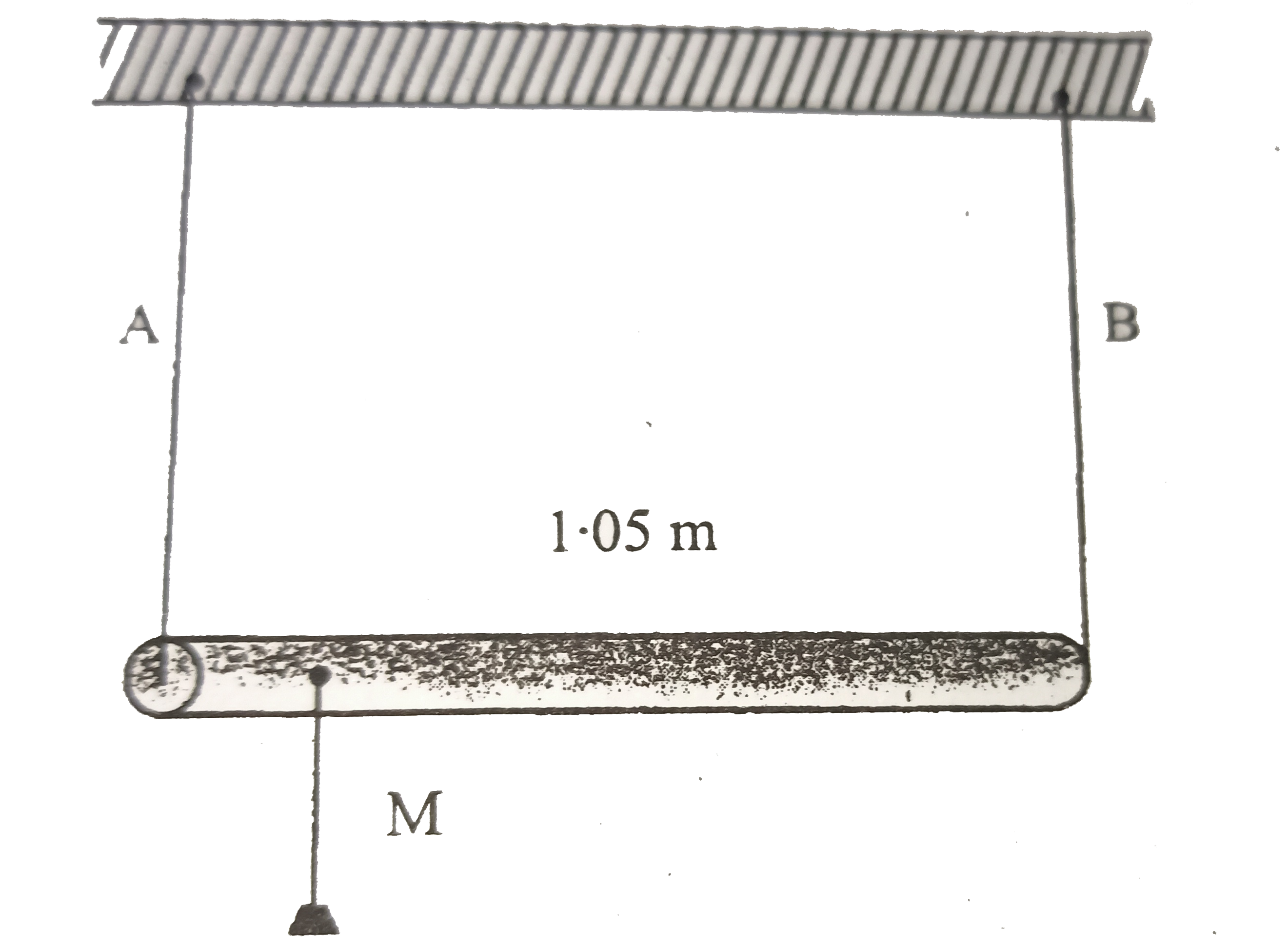 07:39View Solution
07:39View SolutionA rod of length 1.05 m having negligible mass supported at its ends by two wires of steel (wire A) and aluminium (wire B) of equal lengths as shown in respectively. At what point along the rod should a mass m be suspended in order to produce (a) equal stresses and (b) equal strains in both steel and aluminium wires.
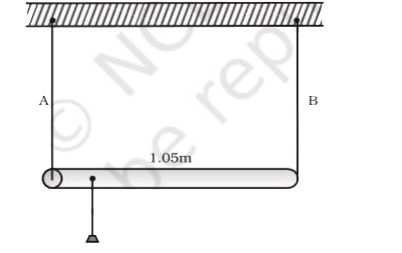 04:02View Solution
04:02View SolutionA rod of length 1.05 m having negligible mass supported at its ends by two wires of steel (wire A) and aluminium (wire B) of equal lengths as shown in respectively. At what point along the rod should a mass m be suspended in order to produce (a) equal stresses and (b) equal strains in both steel and aluminium wires.
04:15View SolutionA rod of length 1.05 m having negliaible mass is supported at its ends by two wires of steel (wire A) and aluminium (wire B) of equal lengths as shown in fig. The cross-sectional area of wire A and B are 1 mm^(2) and 2 mm^(2) , respectively . At what point along the rod should a mass m be suspended in order to produce (a) equal stresses and (b) equal strains in both steel and aluminium wires. Given, Y_(steel) = 2 xx 10^(11) Nm^(-2) and Y-(alumi n i um) = 7.0 xx 10^(10)N^(-2)
07:33View SolutionA rod of length 1 and negligible mass is suspended at its two ends by two wires of steel (wire A) and aluminium (wire B) of equal lengths as shown in figure. The cross-sectional areas of wires A and B are 1.0 mm^(2) and 2.0 mm^(2) respectively. Y_("steel”) = 200 xx 10 ^(9) Nm ^(-2) and Y_("auminium”) = 70 xx 10 ^(9) Nm ^(-2)
03:49View SolutionA rod of length 1.05 m having negliaible mass is supported at its ends by two wires of steel (wire A) and aluminium (wire B) of equal lengths as shown in fig. The cross-sectional area of wire A and B are 1mm2 and 2mm2, respectively . At what point along the rod should a mass m be suspended in order to produce (a) equal stresses and (b) equal strains in both steel and aluminium wires. Given,
Ysteel=2×1011Nm−2andY−(aluminium)=7.0×1010N−2
 05:13View Solution
05:13View Solution

